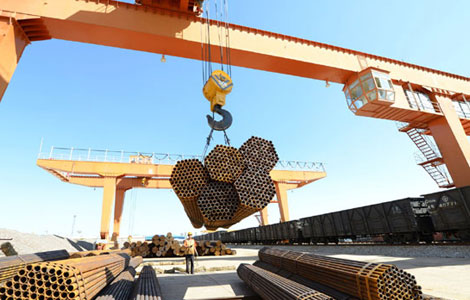Arctic trade route opens
Updated: 2013-08-10 01:26
By ZHONG NAN (China Daily)
|
||||||||
Cosco Shipping Co's new shortcut route to Europe and North America via the Arctic Northeast Passage is expected to change China's industrial layout in its coastal provinces and reshape the prospects for the global shipping sector, said industry experts.
Cosco Shipping, a listed company within China's shipping giant Cosco Group, made its maiden journey on the route with a multipurpose vessel on Thursday. It plans to serve the company's needs in developing the new route and searching for market growth points. The company conducts general and specialized cargo shipping services for Cosco Group.
The ship left Dalian port in Northeast China's Liaoning province and is scheduled to take 33 days to reach Europe. It is the first time a Chinese merchant ship has traveled to Europe via the Arctic Northeast Passage.
The total deadweight tonnage of the multipurpose vessel is 19,461 tons. The ship is expected to arrive in the Bering Strait on Aug 25.
There are three main shipping passages across the Arctic region — the North East Passage, the North West Passage and the Central Route. As the ice melts, the North East Passage opens from the end of July for four months or more, while the Central Route opens from the end of August for one month or more.
With a distance of 2,936 nautical miles (5,437 kilometers), the Northeast Passage is known as the most economical route in this region. Ships from China will sail west across the Bering Strait, through a number of waters including the East Siberian Sea and Vilkitsky Strait before having the option to dock at various European ports.
"Once the new passage is opened, it will change the market pattern of the global shipping industry because it will shorten the maritime distance significantly among the Chinese, European and North American markets," said Qi Shaobin, a professor at Dalian Maritime University.
Qi said because China remains the world's largest exporter, many of its major ports such as Dandong, Yingkou, Qinhuangdao and Tianjin will benefit from the new routes, especially those in the northeast of the country.
Currently, 90 percent of China's trade is carried out by sea. China's trade will grow to $7.6 trillion by 2020, the Polar Research Institute of China forecasts.
Han Yichao, an industrial analyst with Changjiang Securities Co, said if 10 percent of China's trade was shipped through the Arctic routes by then, that could be worth $683 billion.
Cosco Shipping said that the opening of the Northeast Passage has significant commercial potential, in particular under current global economic conditions.
The new passage could cut shipping times between Asian and European ports by about one-third. More importantly, the new route will offer favorable opportunities to all Cosco Group's shipping business during the currently sluggish period because it will cut operating costs, fuel consumption and carbon emissions, the company said.
Because of the imbalance between demand and supply in shipping market, Cosco Group has experienced large net losses over the past two years.
Most Viewed
Editor's Picks

|

|

|

|

|

|
Today's Top News
China's inflation rises 2.7% in July
Industrial growth gaining momentum
Arctic trade route opens
New loans, social financing fall again
Trade disputes hit solar export prices
Student exchange brings global business to life
US woos Chinese investors
Pharm giant says it takes bribery claims 'seriously'
US Weekly

|

|












